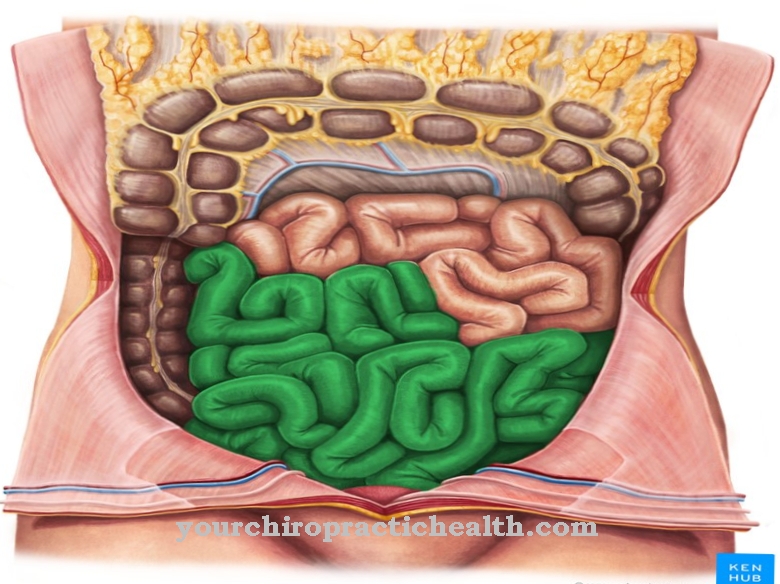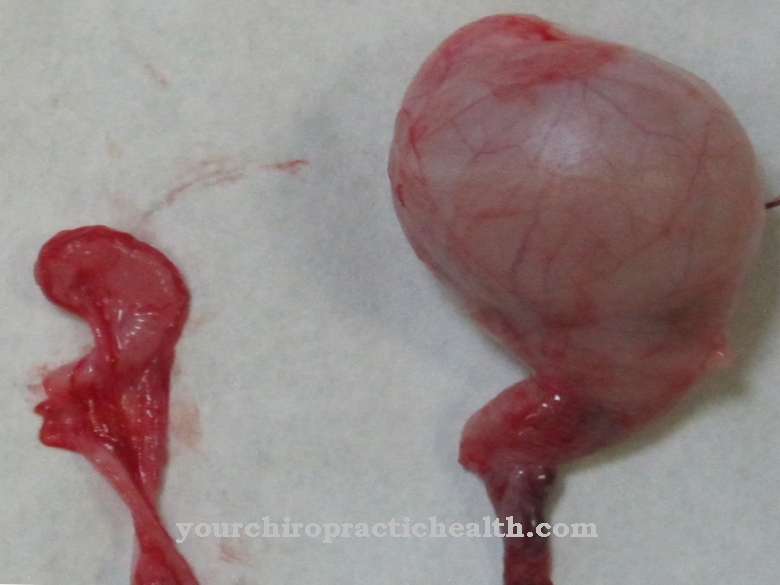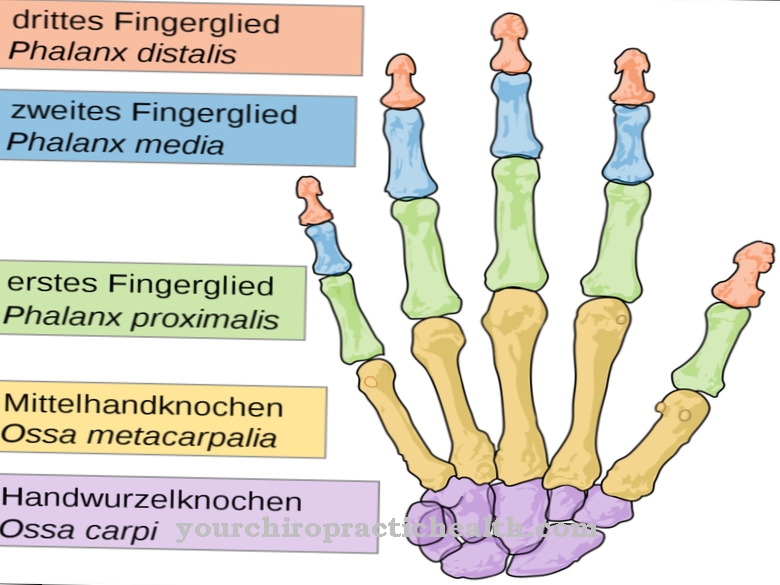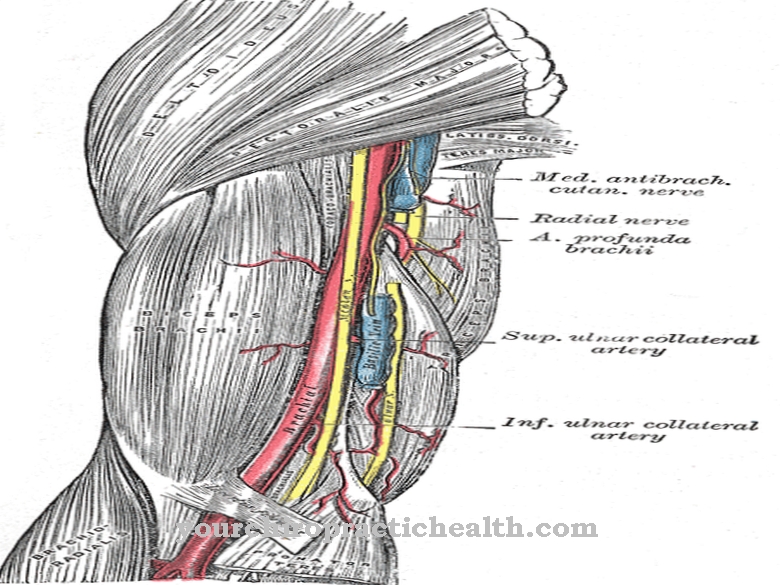The Jacobson's anastomosis is a bundle of nerve fibers in the head and skull area. Its fiber course is responsible for the parasympathetic stimulation (innervation) of the parotid gland.
These nerve connections were discovered by the Jewish-Danish doctor and researcher Ludwig Levin Jacobson (1783-1843). They have their origin in the inferior salivator nucleus, a nucleus of the cranial nerve in the elongated medulla (medulla oblongata). Together with the IX. The cranial nerve (glossopharyngeal nerve) leads its path out of the cranial cavity through an opening in the base of the skull, the so-called throttle hole (jugular foramen).
What is Jacobson's Anastomosis?
Under some other connections (anastomoses) with neighboring nerves, the fibers come into the so-called tympanic cavity (Cavitas tympani). The crucial distribution point for the branches in front of the parotid gland is ultimately the facial nerve.
The Jacobson's anastomosis finally reaches its destination, the parotid gland, as a parasympathetic strand of the glossopharyngeal nerve ("tongue-throat nerve"). The vast network of nerves around the IX. The cranial nerve also guarantees the supply of the middle ear, the so-called cheek glands, the pharynx, the tonsils and the back of the tongue. In this highly sensitive area, defects in the glossopharyngeal nerve can cause various muscle spasms. Possible triggers for this include Tetanus, rabies or strong irritation from foreign bodies.
Damage to the glossopharyngeal nerve can also lead to paralysis of the pharyngeal head muscles and, as a result, massive swallowing disorders. In such cases, the so-called nerve-muscle coupling gets out of balance. Glossopharyngeal neuralgia can also come to light in connection with Jacobson's anastomosis. Sudden severe pain occurs in the wider mouth area, which can extend to the ear region. They are clearly noticeable in the simplest movements of chewing, swallowing, and speaking.
Anatomy & structure
The parotid gland (parotid or parotid gland) supplied with nerve irritation by the Jacobson anastomosis is the largest salivary gland in the entire jaw and mouth area. It is located in front of and under the ear on both sides of the face.
The parotid gland extends from the so-called zygomatic arch to the angle of the jaw. The shape is triangular and flat. The parotid gland weighs 20 to 30 grams. It is provided with a fascia (capsule made of connective tissue). Inside it is divided into small lobules. This is where the parotid gland cells are located, which secrete the so-called primary saliva. This has the peculiarity of changing its composition the further it advances in the derivative system. The so-called duct of the parotid gland runs largely similar to the masticatory muscles. It runs through the cheek muscles and the lining of the cheek. The end point of the parotid duct is in the oral cavity. As a rule, it can be clearly seen in the mouth as a small dark-colored point opposite the upper molars.
In addition to the leading Jacobson anastomosis, the parotid plexus can also be found in the parotid gland. This is composed of fibers of the VII. Cranial nerve (nervus facialis). The fibers leading away from it are essentially responsible for activating the facial muscles. The parotid gland is also reached by branches and extensions of the trigenimus nerve. In the area of the parotid gland, the external carotid artery also divides into its two terminal branches. The outflow of blood initially takes place via branches of the parotid vein. Lymph from the parotid reaches the outside via the so-called parotid lymph nodes.
Function & tasks
The saliva produced by the parotid is in a so-called pure liquid state, i.e. watery and completely without mucous (slimy) components. It is thin, slightly alkaline and has a relatively large proportion of proteins and enzymes. Of these, the enzyme amylase is very important for the decomposition of carbohydrates.
The saliva of the parotid is also characterized by its proportion of immunoglobulins, which serve the biological defense in the mouth area. More or less common diseases of the parotid gland are tumors and mumps (goat peter). Mumps occurs mainly in childhood and is characterized by severe swelling of the parotid gland as a result of a viral infection. Such swellings should always be carefully examined by a specialist, as they can have a wide variety of malignant causes. The main danger is that the inflammatory swelling can quickly spread to sensitive areas of the brain.
Diseases
Various malfunctions of the Jacobson anastomosis can lead to a whole range of impairments of the parotid gland. Inflammation in particular spreads quickly because the parotid gland with its gland duct has open access to the oral flora.
The flow of saliva in the gland is sometimes severely hindered by the formation of stones. Dangerous bacteria can easily gain access through these salivary stones, which in turn can trigger new inflammations. It is not uncommon for chronic infections to occur that must be treated with antibiotics. The salivary stones are usually preceded by a changed composition of the saliva. They consist primarily of calcium phosphate and can usually be removed using simple surgical methods. With the help of ultrasound there is also the possibility of breaking up the salivary stones so that they can be removed naturally through the canal system.
Benign tumors that affect salivary glands in the human body affect about 80 percent of the parotid gland. Since they can degenerate, it may still be advisable to remove them. In contrast, the removal of malignant tumors of the parotid gland is often the only possible therapy. However, the risk of this operation is high because a large number of facial nerves run through the parotid gland.













.jpg)

.jpg)
.jpg)











.jpg)